The total guide to SMS marketing (+Examples & strategies)

What if I told you there was a marketing strategy that has 5X the response rate of email? That reaches 2 in 3 Americans? And helps 73% of marketers who use it to drive more revenue?
This is SMS marketing—a powerful tool that allows businesses to communicate directly and immediately with customers via text message (SMS).
In a world when 91% people keep their smartphone in reach 24/7, text messages can be a highly effective way to reach and engage your customers.
In this comprehensive guide, we'll walk you through the ins and outs of SMS marketing to help you maximize success with this promising strategy.
Specifically, we'll cover:
What is SMS marketing?
SMS marketing is a form of marketing that involves sending text messages (SMS) to customers and prospects on their mobile phone. These SMS notifications (messages) are sent to recipients who have chosen (opted-in) to receive them.
SMS are limited to 160 characters of text and emojis, so they’re perfect for concise business messages and time-sensitive outreach, such as:
Promotions
Product announcements
Order updates and support
These communications can be convenient and valuable to customers, so it's no surprise that 54% of consumers say they want to receive marketing promotions via SMS from businesses.
By sending timely and personalized business messages, SMS marketing enables a business to reach and engage its audience, drive sales, and build customer relationships.

Benefits of SMS marketing
Businesses that use SMS marketing do so for a few main reasons:
Increase engagement
Generate conversions and sales
Deliver time-sensitive information
Provide efficient customer service
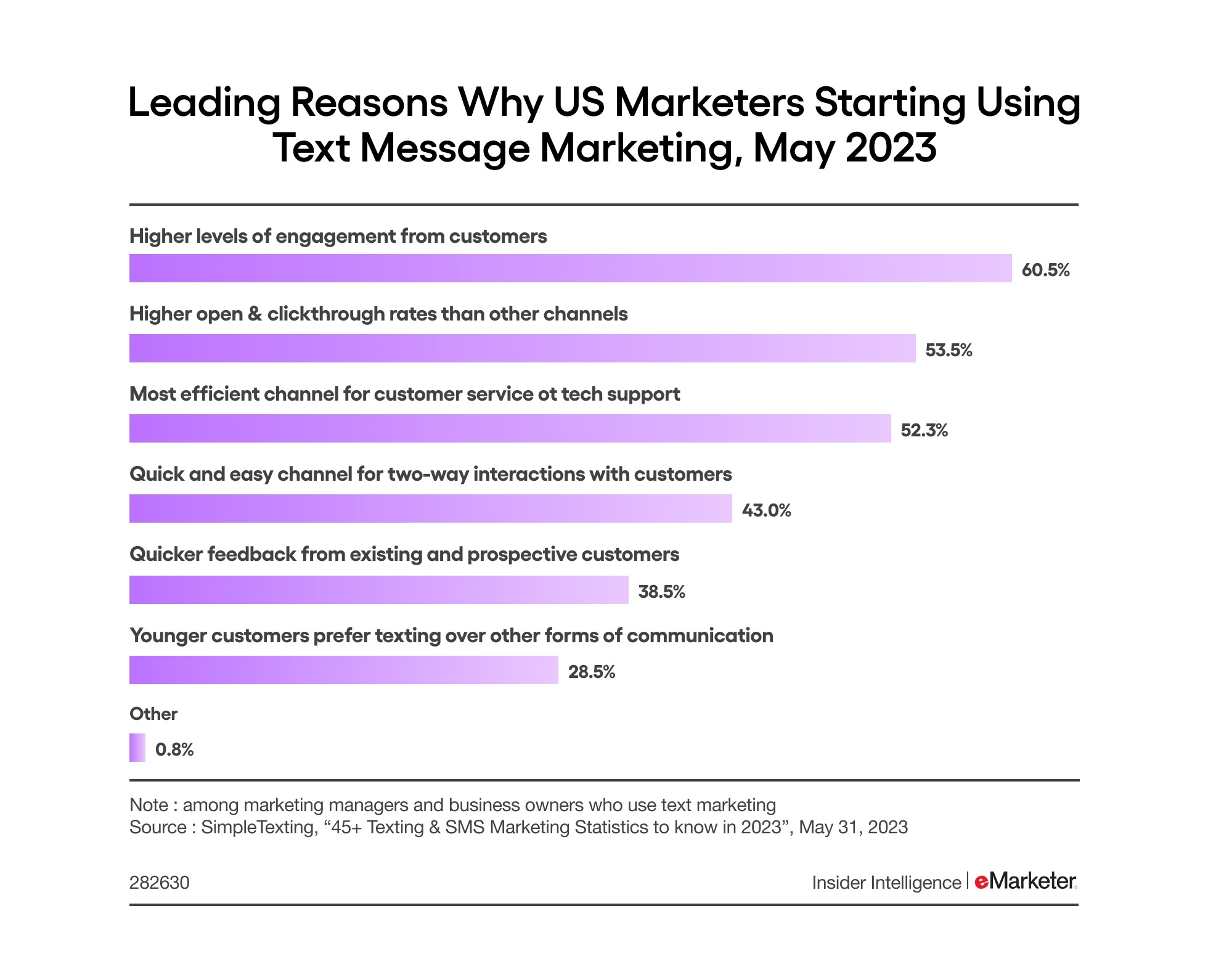
In an age when email inboxes are overflowing, SMS messages can be a great way to cut through the clutter and reach customers directly. SMS has a few other major advantages over other channels, so it's often a pillar of omnichannel marketing strategies.
Let’s look at how SMS marketing can boost your reach, increase sales, and help you build stronger relationships.
1. Direct communication
The average American spends four hours per day on their phone, and checks it 144 times. As a result, SMS is almost a direct line of communication to your audience.
Using SMS allows a business to reach its audience on a device that customers already pay a lot of attention to.
Since people are more likely to see SMS texts compared to other types of outreach, SMS marketing is an effective way to send a variety of timely and personalized messages.
2. Real-time updates
SMS messages are delivered instantly anywhere in the world via cellular networks. What’s more, they’re read almost instantly as well.
In fact, 95% of text messages are opened within three minutes of being received.
This immediacy makes SMS a perfect way to share time-sensitive offers and information, such as announcements, updates, and flash sales.
And since push notifications for text messages remain on the device home screen until the message is opened, SMS campaigns stay visible even if the recipient is away from their phone when the message arrives.
3. Incredible open rates
SMS messages enjoy a staggering 98% open rate. By comparison, a study by Mailchimp found that the average open rate for email marketing is just 18%.
This high level of engagement is due to SMS containing valuable or time-sensitive information, while also being short and simple.
SMS are almost sure to be seen, and their inherent simplicity also makes it easy for the recipient to take action.

4. High response rates
SMS messages are far more likely to generate a response than other marketing channels. On average, SMS marketing messages have a response rate of 45%, while the average response rate for email hovers around 7%.
Given their high engagement and open rates, SMS campaigns are a reliable way to drive traffic to a website, store, or mobile app.
5. Cost-effective
SMS stands out as a cost-effective form of outreach, as short texts don’t require the same investment as other mediums.
After all costs are counted, it’s around $0.09 - $0.50 to send an SMS message. This number can vary by your choice of SMS provider, message volume, SMS marketing platform fees, or different types of SMS messages.
For context, SMS can be slightly more expensive than sending emails. However, the higher open rates and engagement than email can easily make up the difference. SMS is also much cheaper than CPC (cost-per-click) marketing, which costs around $6 per click on average.
6. Omnichannel ready
SMS marketing is strong by itself, but it really shines in omnichannel strategies. For instance, you can use SMS to promote an upcoming event, contest, or a limited-time offer in coordination with other marketing channels.
American Eagle Outfitters, for example, ran a 12-day cross-channel giveaway campaign that allowed SMS subscribers to win prizes and discounts. The cross-channel campaign involved the brand website, social platforms, direct mail and in-store signage.
SMS was the key to the campaign’s success, according to the marketing director, as 60% of SMS subscribers engaged with the prize pages within minutes of receiving the texts.

How to build the perfect mix of mobile customer communication channels
SMS marketing examples
SMS marketing is a popular business strategy that’s relevant at every stage of the customer lifecycle, especially since most people prefer texting with a business to calling or emailing.
Let’s look at some SMS marketing examples that show how businesses use text messages to engage customers, drive conversions, and build better relationships.
1. Send a welcome message to new subscribers
It’s good to welcome your new SMS subscribers. This lets them know they’ve subscribed successfully and sets the tone for future interactions.
A welcome message can be short and sweet. A simple “Thanks for subscribing!” is enough. You can even include a coupon code or a special offer to reinforce the value of your SMS program.
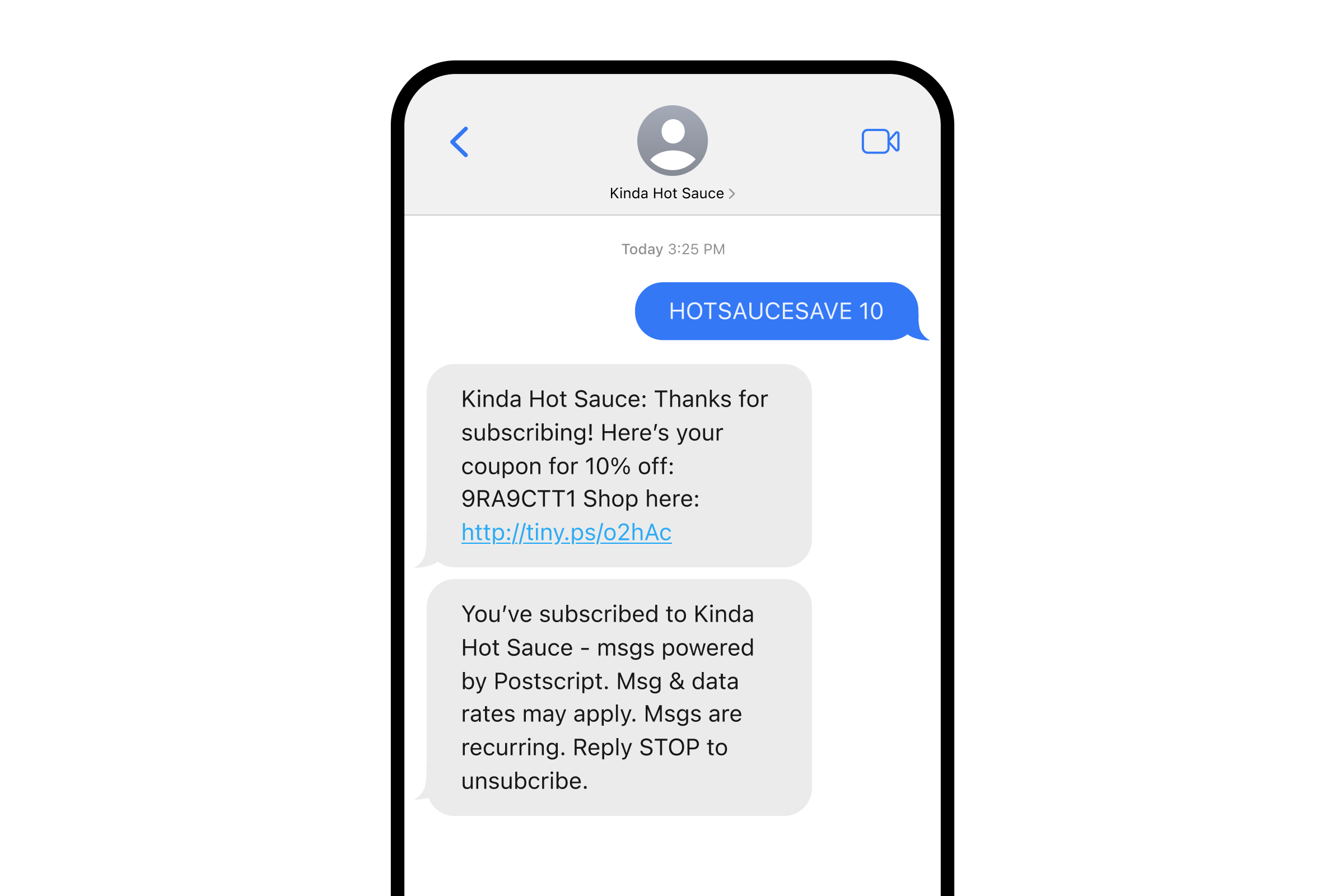
2. New product announcements
Another great way to use SMS marketing is to drive awareness for new products and services. This will help you generate hype for new offerings, and re-engage people who haven’t shopped for a while.
You can drive traffic to your website or product listing by including a link in your SMS messages. For example, a message to “Check out our new releases” can motivate people to visit your site.
And since SMS recipients have opted-in to these messages, you can expect higher click-through rates and conversions.

3. Order confirmations and shipping updates
SMS marketing is a perfect way to send order confirmations and shipping updates. It allows customers to receive an automated text instantly once their order is placed, rather than having to open and check email.
In other words, SMS messaging is a time-saving and convenient upgrade to the customer experience.

4. Time-sensitive offers
SMS is ideal for ensuring customers have every opportunity to take advantage of a limited-time sale or special promotion. For best results, you can write your SMS marketing messages to emphasize the urgency of your limited-time offering.
A sense of urgency will tap into the fear of missing out (FOMO) that arises when supplies are limited, and, combined with the immediacy of SMS texts — help you drive more sales.
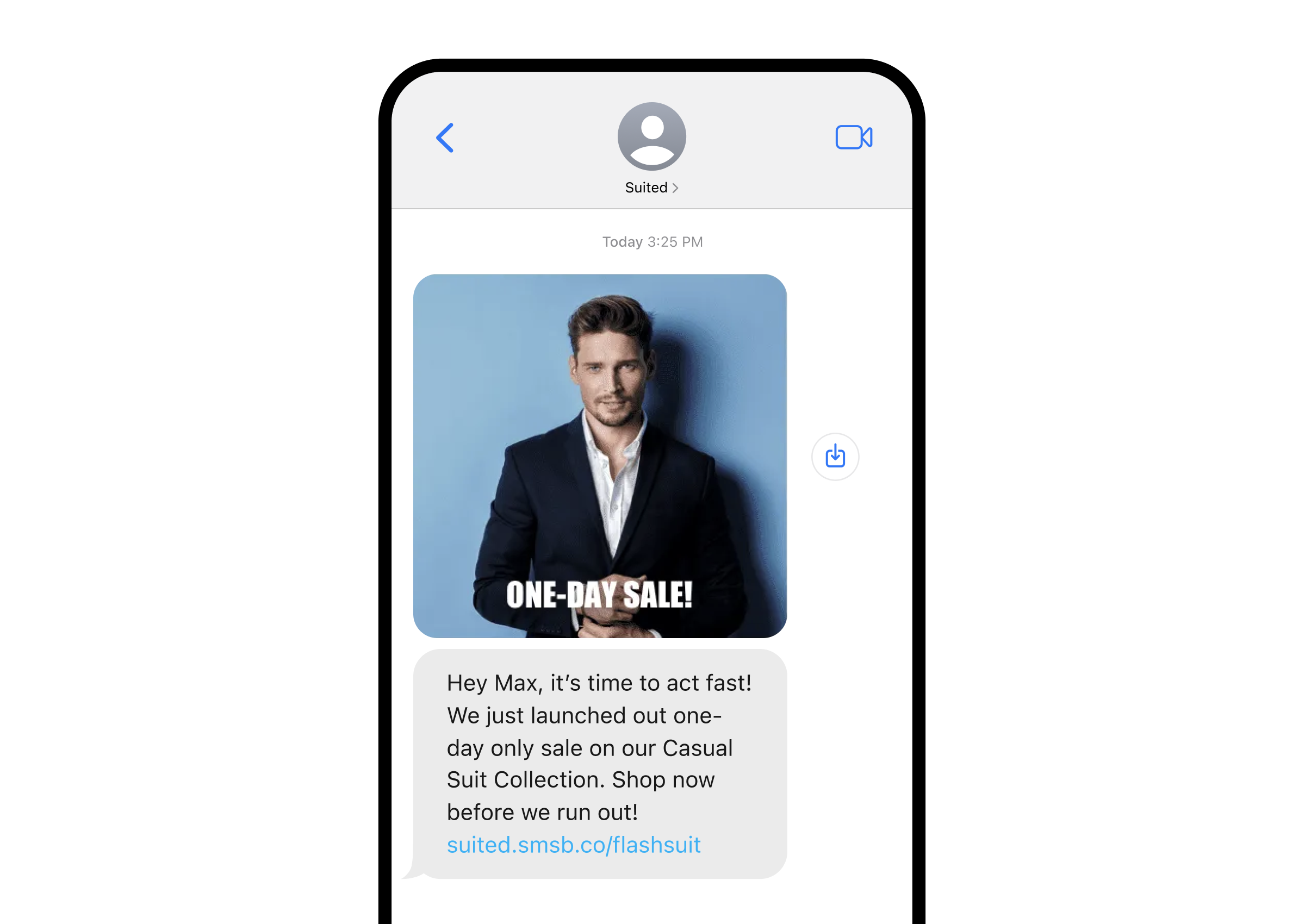
4. Appointment reminders
SMS messages are the preferred way to receive appointment reminders and confirmations for most people.
It’s simply more convenient to confirm an appointment via text than composing an email. For this reason, SMS is commonly used by service businesses to streamline the customer experience and reduce no-shows.
For instance, the medical provider Denver Health uses SMS for healthcare to send checkup reminders to patients and improve attendance. In three years, the health provider increased appointment attendance by 13% with SMS healthcare marketing.
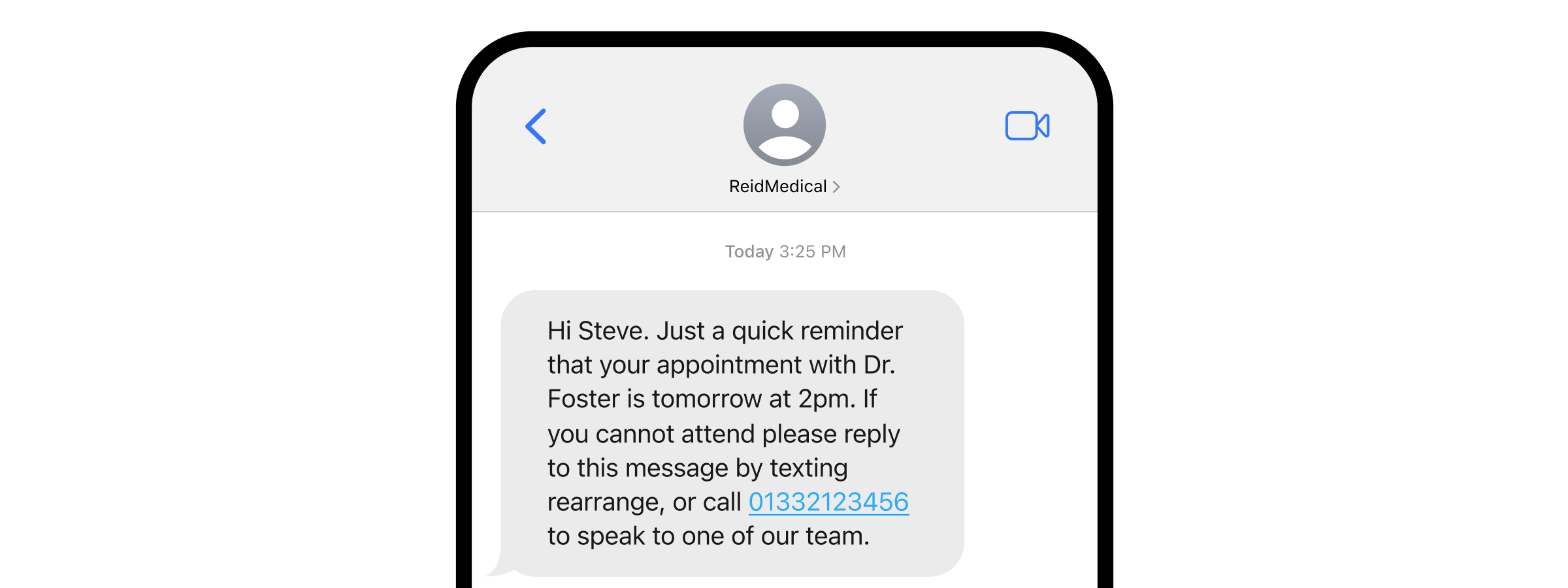
5. Product restock notifications
It’s frustrating when a desired product is out of stock, so many people subscribe to SMS programs to be the first to know about restocks.
With ecommerce SMS marketing, online stores can notify customers when a product is back in stock, driving sales within a customer segment that’s primed and eager to buy.
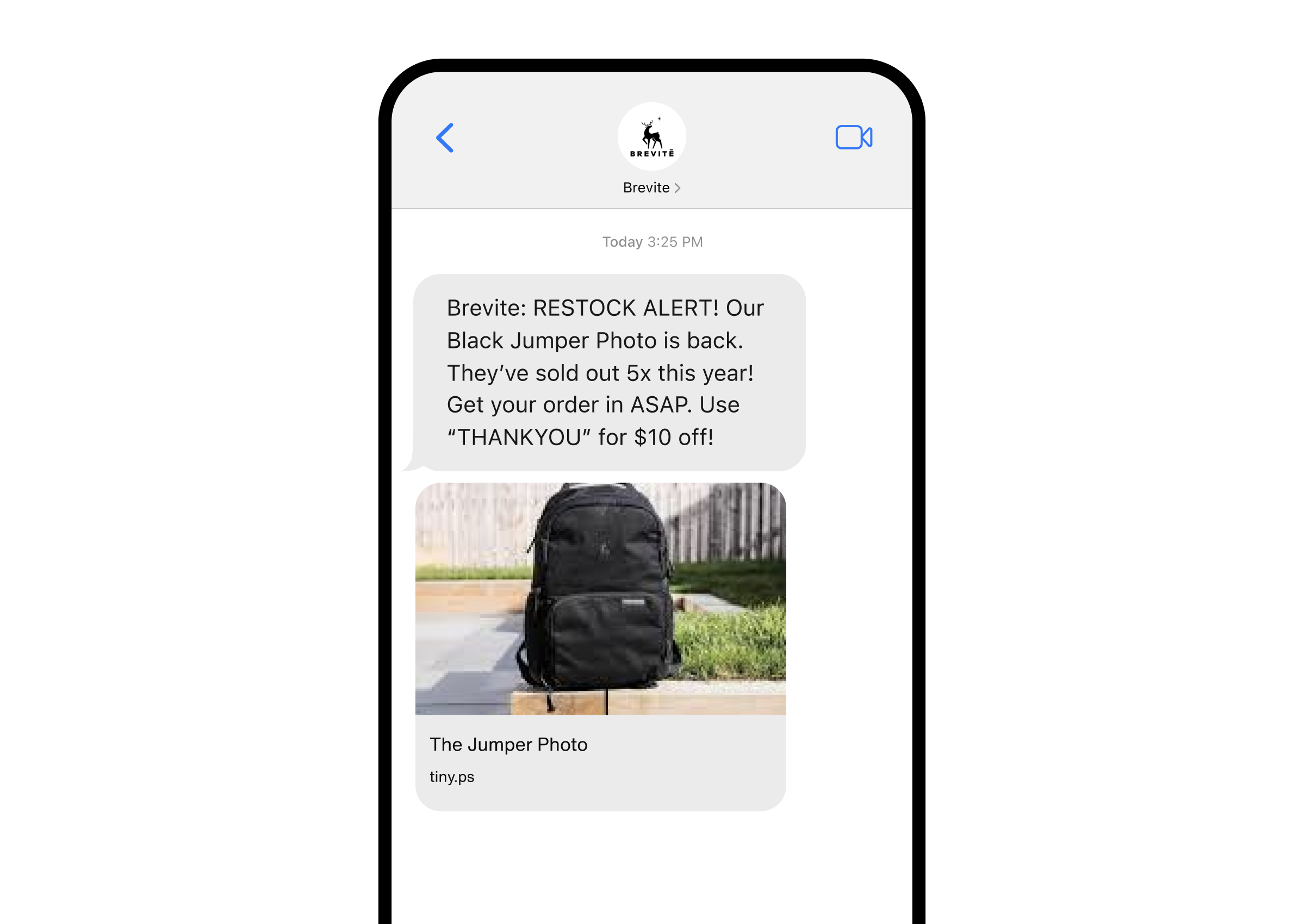
6. Customer service
SMS can enhance customer service efforts and improve customer satisfaction scores (CSAT).
For instance, businesses with a mobile workforce (such as delivery drivers or electricians) can notify customers via text about the incoming service provider. If the customer needs to contact the worker or the company, they can send a text instead of making a phone call — saving time for the customer and the business.
SMS for customer service can also proactively address issues before they turn into problems. In the example below, a real estate company uses SMS notifications to announce maintenance repairs, preventing an influx of calls from residents.

7. Customer feedback
Customer feedback is crucial to business improvement, and SMS texts are a quick and easy way to ask customers what they think.
After creating a survey with a tool like Google Forms, you can send a link to subscribers via SMS to learn their experiences and opinions.
You can also follow up with customers after a particular experience, like a support call. If you don’t want to ask for a full survey, you can instead request a quick rating to help you identify areas of improvement.
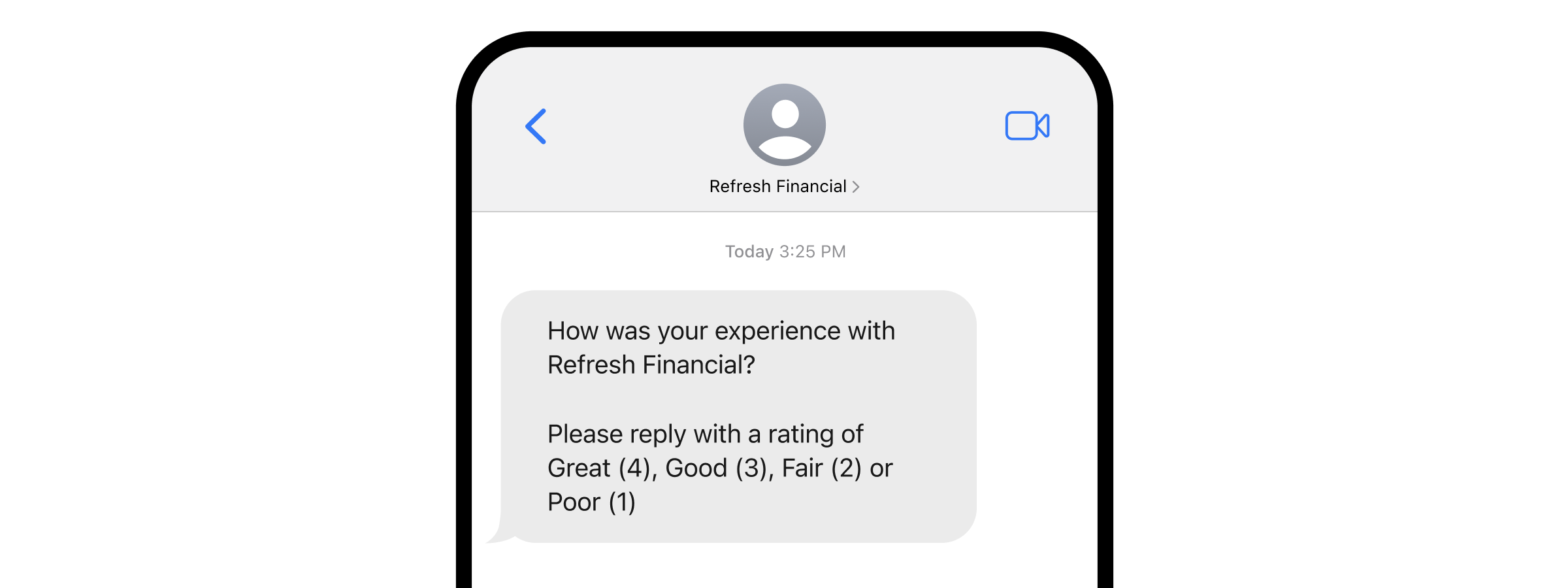
8. Event promotions
SMS marketing is a great way to generate buzz for an upcoming event, sweepstakes, or contest among a highly receptive audience.
Giving SMS subscribers early or exclusive access to online or in-person events will bolster their loyalty, while also incentivizing others to join your SMS marketing campaigns.
Event promotion texts should include all the relevant details about the event: date, time, location, and a call to action (CTA) link for purchasing tickets or saving a spot.
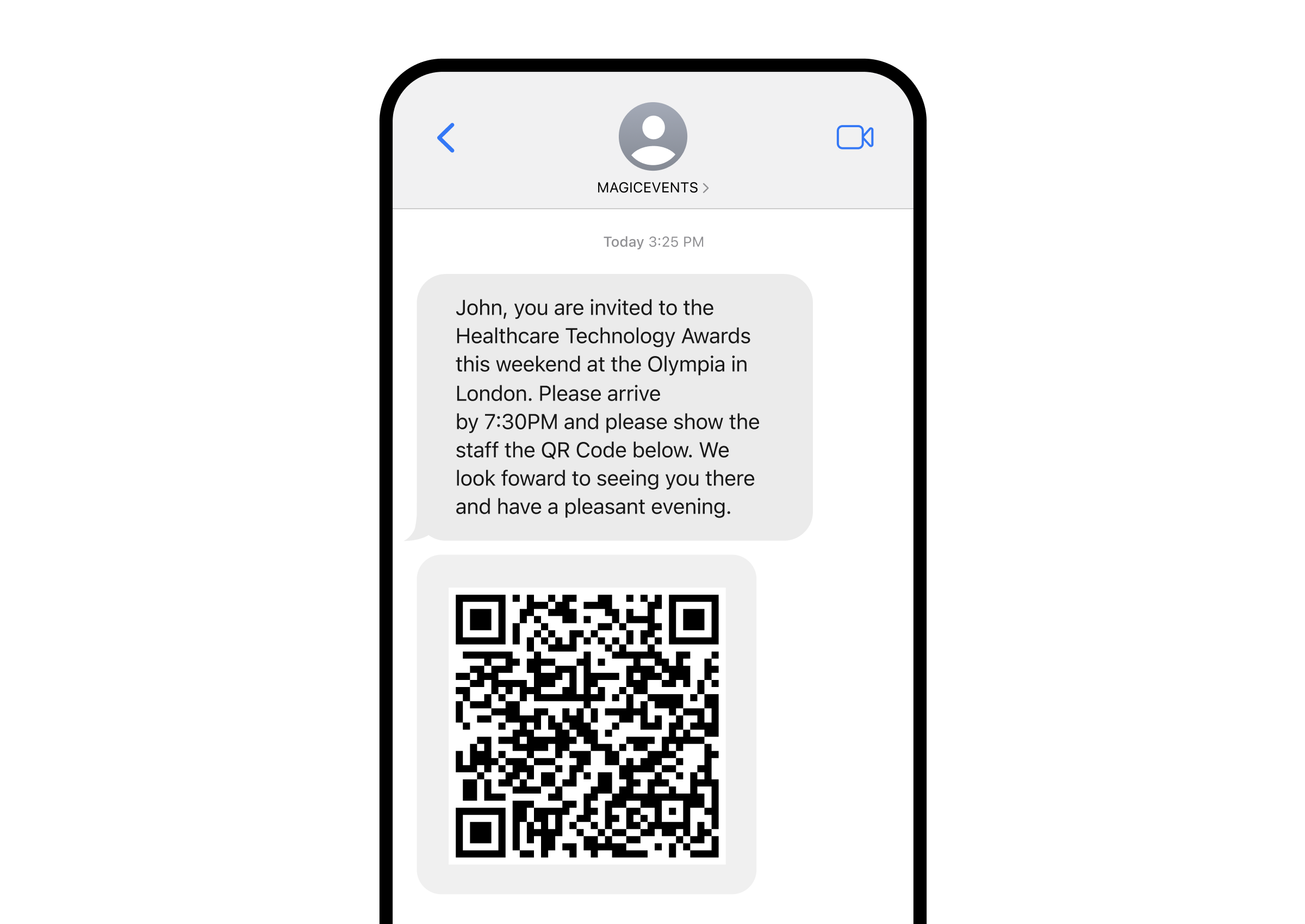
9. Loyalty programs
SMS is an ideal channel for expanding your customer loyalty program. It’s more immediate than email, allowing you to keep members informed about their rewards balance, exclusive offers, and important announcements in real-time.
To promote your SMS loyalty program, you can include a signup link on your website, social media, email, or point of purchase.
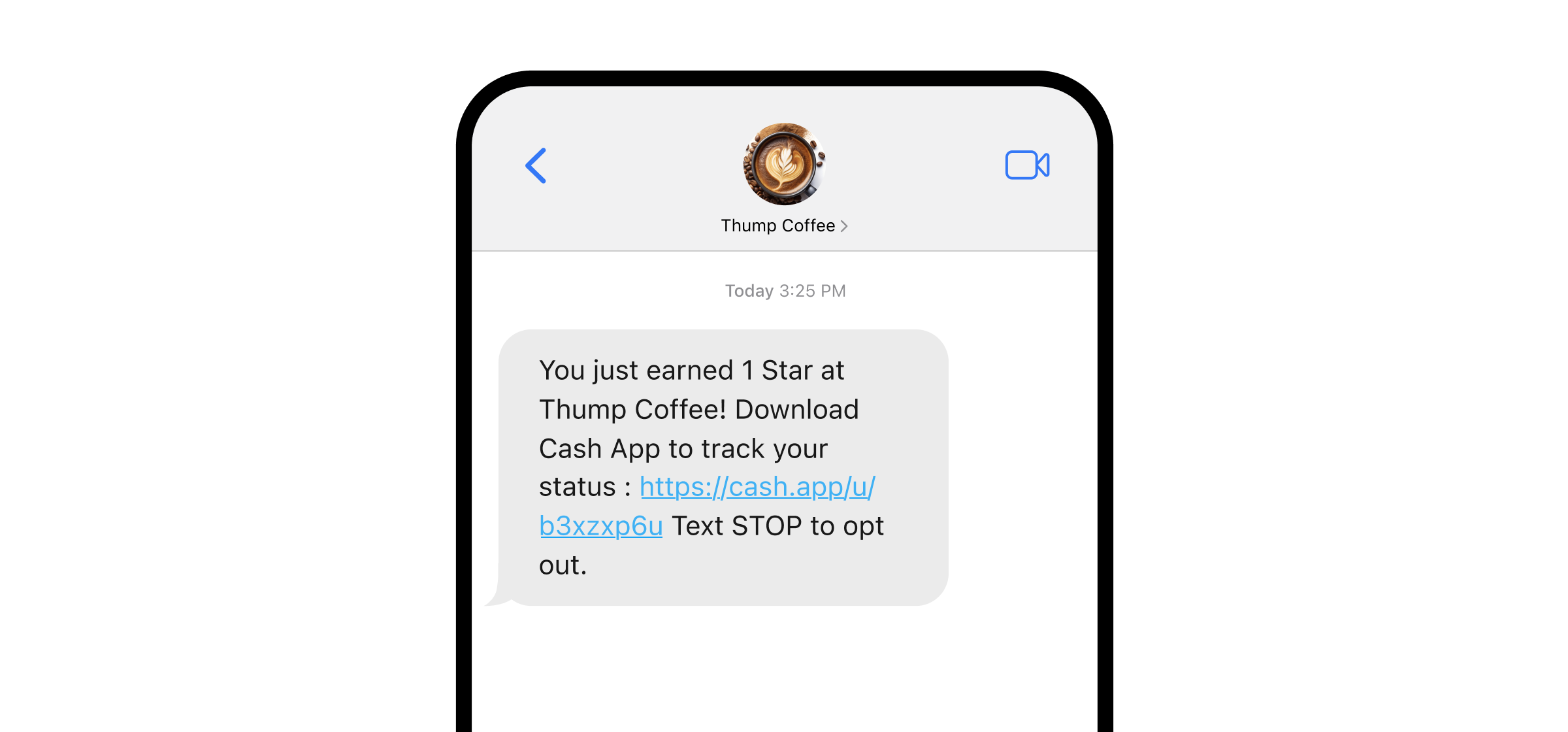
10. Personalized offers
SMS is an intimate medium that’s great for showing customers they’re valued.
For example, you can use SMS messaging to highlight a special occasion like a birthday, celebrate a one-year anniversary in your loyalty program, or just thank them for being a customer.
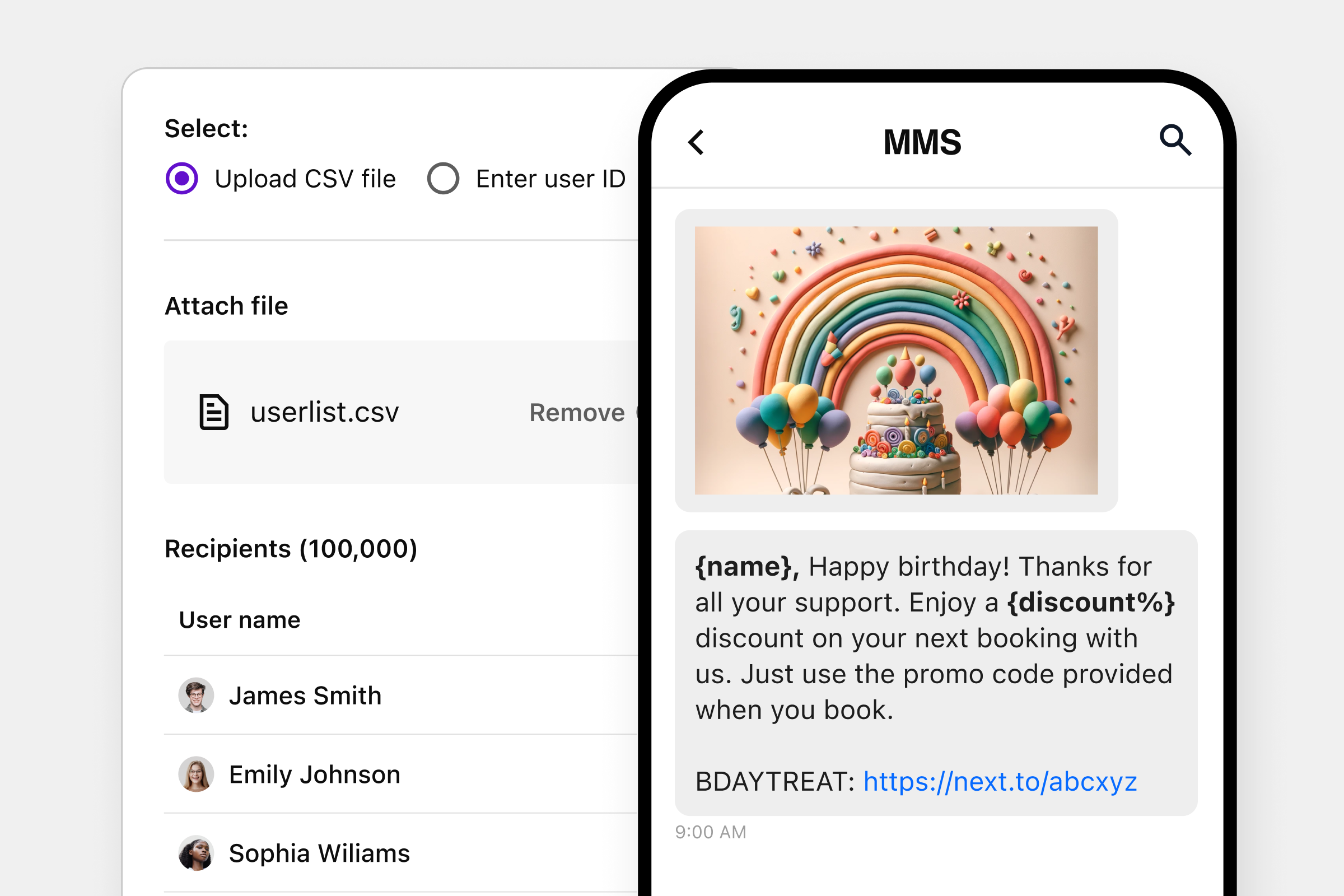
What communication channels do modern customers prefer?
SMS marketing best practices
People are protective of their mobile phones, so it’s important to get your SMS marketing right from the start. To help you avoid unsubscribes, here are the do’s, don’ts, and best practices of SMS marketing to know before you begin.
1. Get permission
Businesses are required by law to get explicit consent from recipients before sending a single SMS. You can get consent by placing opt-in forms and pop ups around the customer journey, including your:
Website
Social media
Email newsletters
In the example below, the clothing retailer Skims uses a website popup to invite customers to sign up for SMS notifications. In exchange for a phone number, the brand offers shoppers first look at new collections and product restocks as an incentive.
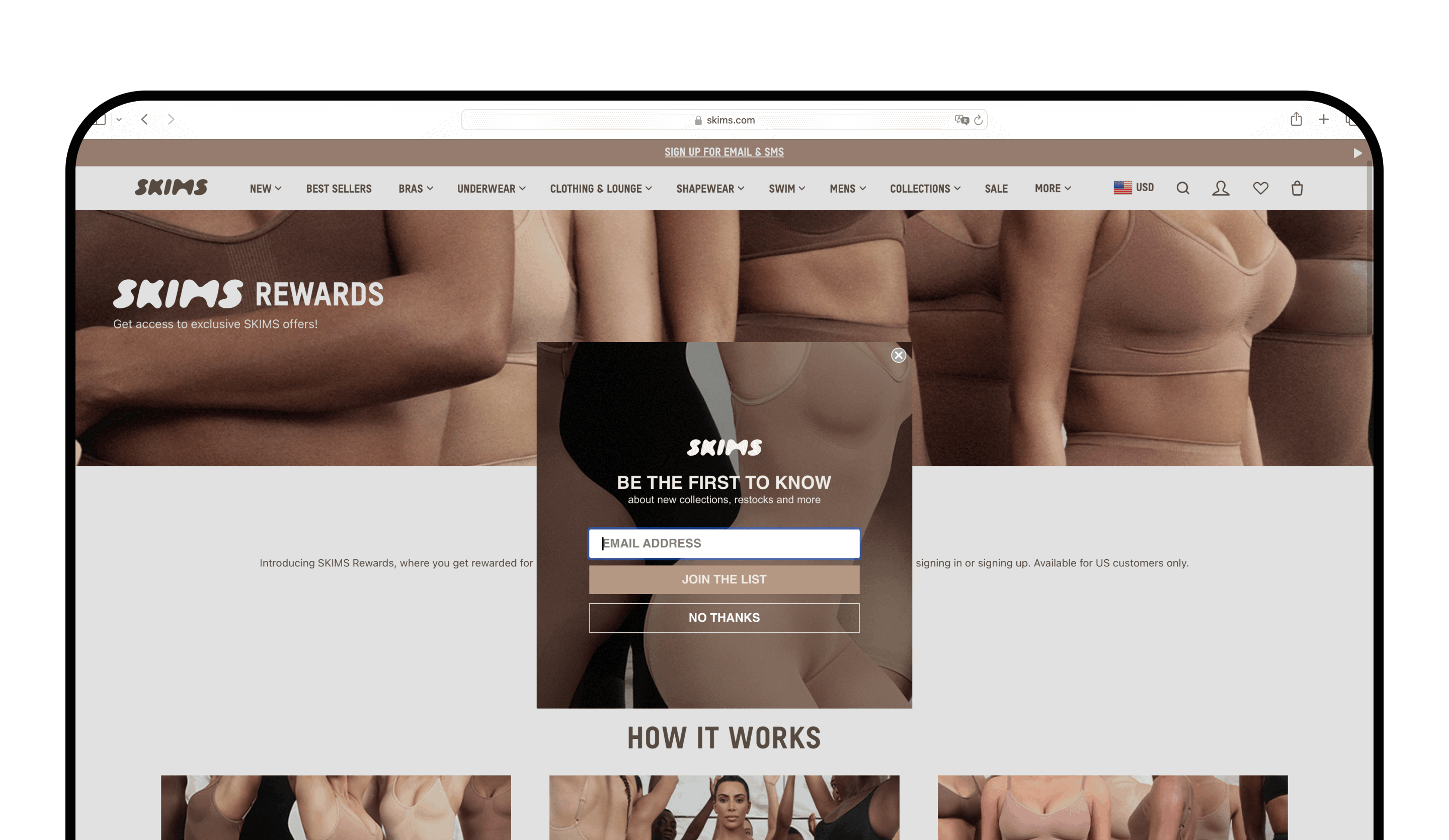
Another way to drive sign-ups for SMS marketing is a text-to-join campaign. Customers can simply text a keyword to your business number, so you’ll just need to promote that number to drive awareness and opt-ins for your SMS marketing.
Lastly, it’s crucial to be transparent with subscribers. Tell people what types of messages they can expect, how often, and assure them you won’t abuse their trust. Full disclosure is the best policy, or you may have trouble maintaining a subscriber list.
2. Keep it short
SMS messages are limited to 160 characters of text, so it can feel like a challenge at first to create a message that’s both compelling and concise. As a rule of thumb, use simple language, be engaging, and don’t forget about emojis.
Until you get the hang of writing SMS for marketing, you can follow this checklist of what to include:
Company name
Customer name
Enticing offer or important information
Call to action
Opt-out option
If you want more space, you can use a link shortener tool like Bitly.
3. Avoid pet peeves
Because people are so connected to their phones, a big part of succeeding with SMS marketing is avoiding people’s pet peeves. Data shows that the biggest texting turnoffs for people are:
Too many messages
Texts on weekends or evenings
Annoying tone or language
Irrelevant or lengthy texts
Depending on your brand or industry, the best practice is to send 1-2 messages per week. This way, you can start to build a relationship with subscribers without barraging them with SMS alerts.
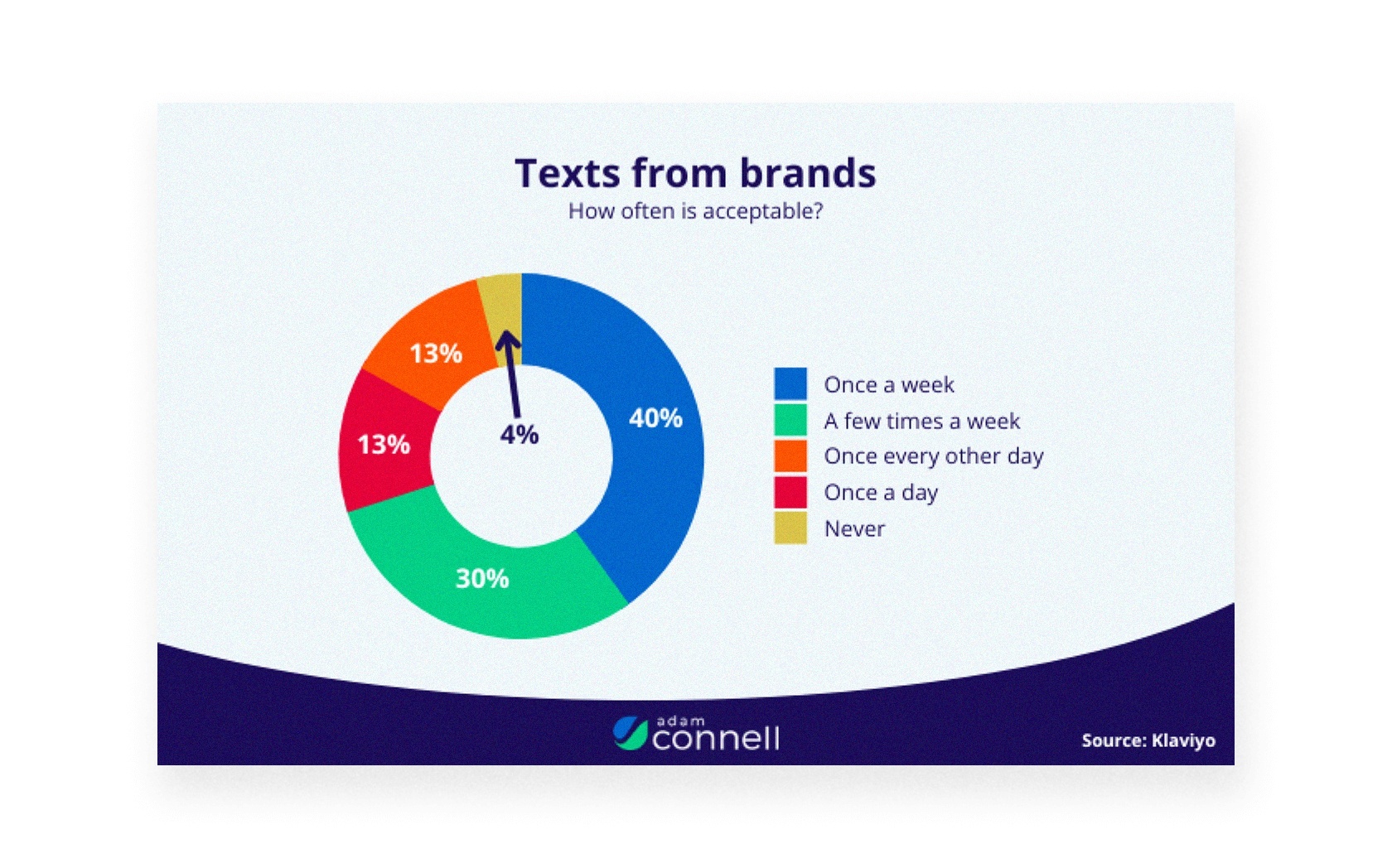
4. Offer an opt-out
Just like gaining consent is a legal requirement, every SMS marketing message must contain a way to opt-out. This could be allowing recipients to reply to a text with a “STOP,” or you can include an unsubscribe link.

5. Mention your business
If your SMS recipients don’t know who you are, they probably won’t understand your message and are more likely to unsubscribe.
One study found that 60% of consumers will immediately unsubscribe from SMS marketing that doesn’t have a clear message or purpose.
Identify yourself to recipients in every message. This way, customers don’t have to remember the context of your messages, which will help maintain trust in your brand.
6. Include a call to action
To encourage recipients to take the next step, it’s best to include a clear call to action (CTA) in your SMS campaigns.
A good CTA adds context to your message and promises a desirable benefit.
Some example CTAs:
Visit <link> by 12 pm EST to secure your early access tickets
Use <code> at checkout for free shipping
Subscribe using <link> to receive weekly developer hacks in your email
7. Use MMS messages
Once you get the hang of SMS, you’ll be ready for the next level: MMS.
MMS (Multimedia Message Service) is an enhanced form of SMS that allows you to send images, videos, GIFs, and other multimedia in your texts. (SMS is text-only).
MMS also gives you 1,600 characters of text, so you’ll have more space to inform and delight customers.
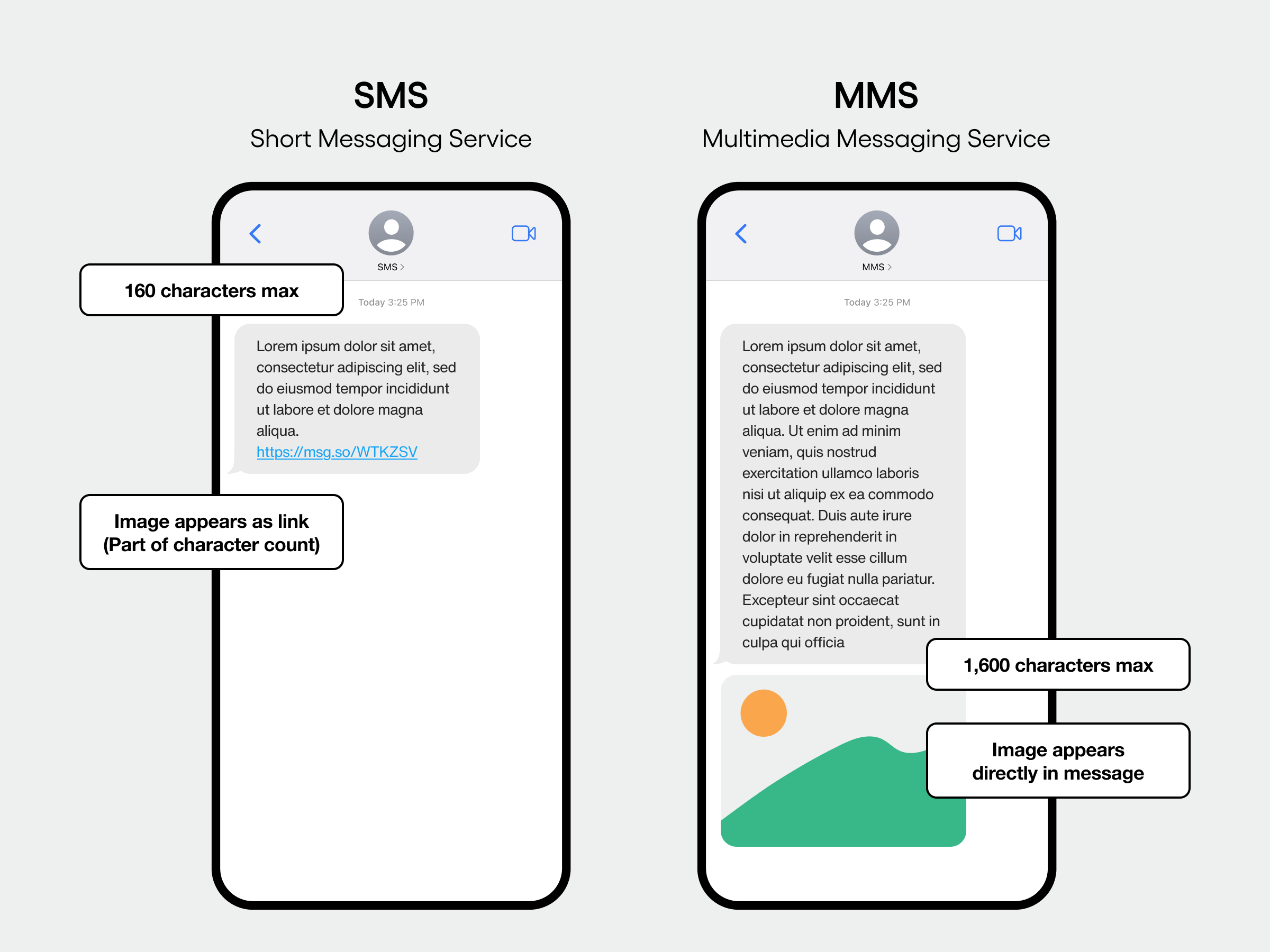
MMS is a powerful addition to SMS marketing. Studies show that MMS marketing campaigns drive 20% higher opt-in rates than SMS-only campaigns, and 15% higher click-through rates.
Top SMS marketing software like Sendbird allow you to send both SMS and MMS messages in one integrated solution and dashboard.
To learn more about MMS, check out our blog about SMS vs MMS.
Discover the unexpected costs of SMS & the savings of omnichannel messaging
How to develop an SMS marketing strategy
If you want to reach your customers in the moment to drive engagement and sales — and who wouldn’t want that? — it may be time to consider an SMS marketing strategy. Here’s how to get started.
Build a list of SMS subscribers
Your subscriber list is the most important part of your SMS marketing strategy. Here are a few tips to help you grow your SMS list:
Offer incentives: People join SMS campaigns to gain value and convenience, so offer access to exclusive content, early releases, VIP events, or discounts to drive signups.
Simplify opt-in: Use easy-to-remember shortcodes or text-to-join campaigns to ease the signup process, adding signup forms and pop ups to high-traffic pages and channels.
Obtain (and keep) consent: To ensure legal compliance and maintain trust, always secure opt-in consent from subscribers (even using double opt-in if needed).
Analyze and optimize: Review the performance of your opt-in campaigns and adjust as needed using analytics in with top SMS marketing software.
The following example of a text-to-join campaign shows how a desirable discount within a simple signup flow can effectively drive subscriptions.

Get an SMS marketing software
SMS marketing software helps a business to streamline the entire SMS marketing process, from campaign creation to delivery to performance tracking. These platforms help you to automate, personalize, and optimize SMS campaigns at scale from a single dashboard.
SMS marketing software integrates with marketing tools like email, CRMs, and ecommerce systems like Shopify, allowing you to create multi-channel campaigns and collect first-party data.
Features like SMS campaign builders, automated notifications, and channel sequencing allow you to send messages at the right time without manual effort, while analytics helps you adjust campaigns based on insights and drive the best possible ROI.
As a G2 leader for years, Sendbird is a trusted SMS marketing platform for businesses that want to add SMS and MMS to their marketing mix using a scalable SMS API. Our omnichannel SMS API also has integrations for WhatsApp, in-app messaging, and mobile push notifications channels.
Create your SMS marketing campaign
Creating an effective SMS marketing campaign may feel a bit daunting at first. Fortunately, SMS marketing software includes SMS templates, so you can launch your first campaign in a few simple steps:
Collect phone numbers: Upload a list of phone numbers from a file that you’ve gathered using signup forms, and validated using a number validator tool.
Customize the experience: Give your campaigns the look and feel of your brand, including the layout, color, and more.
Schedule messages: Research suggests sending messages during active hours (8 AM to 5PM) to reach people at a time when they’re receptive to texts from business.
Send your first SMS campaign: Add message copy to the SMS builder template, then launch your campaign as a standalone effort or within a multi-channel strategy.

As you craft your SMS messages, keep these tips in mind to help maximize engagement:
Focus on providing value to subscribers in every message
Maintain a professional yet brand appropriate tone
Use proper grammar and avoid uncommon slang or abbreviations
Automate as needed
To streamline and save time, you can automate SMS campaigns with SMS marketing software.
You can also integrate SMS with your multi-channel automation workflows, delivering a consistent experience for your audience that aligns with your other efforts, like push notifications or email.
Here’s an example of an automated workflow:
An SMS is sent to welcome a new subscriber, plus a welcome email
A second SMS is sent two days later with a product recommendation
A third SMS is sent a week later with a discount code, plus an email offer
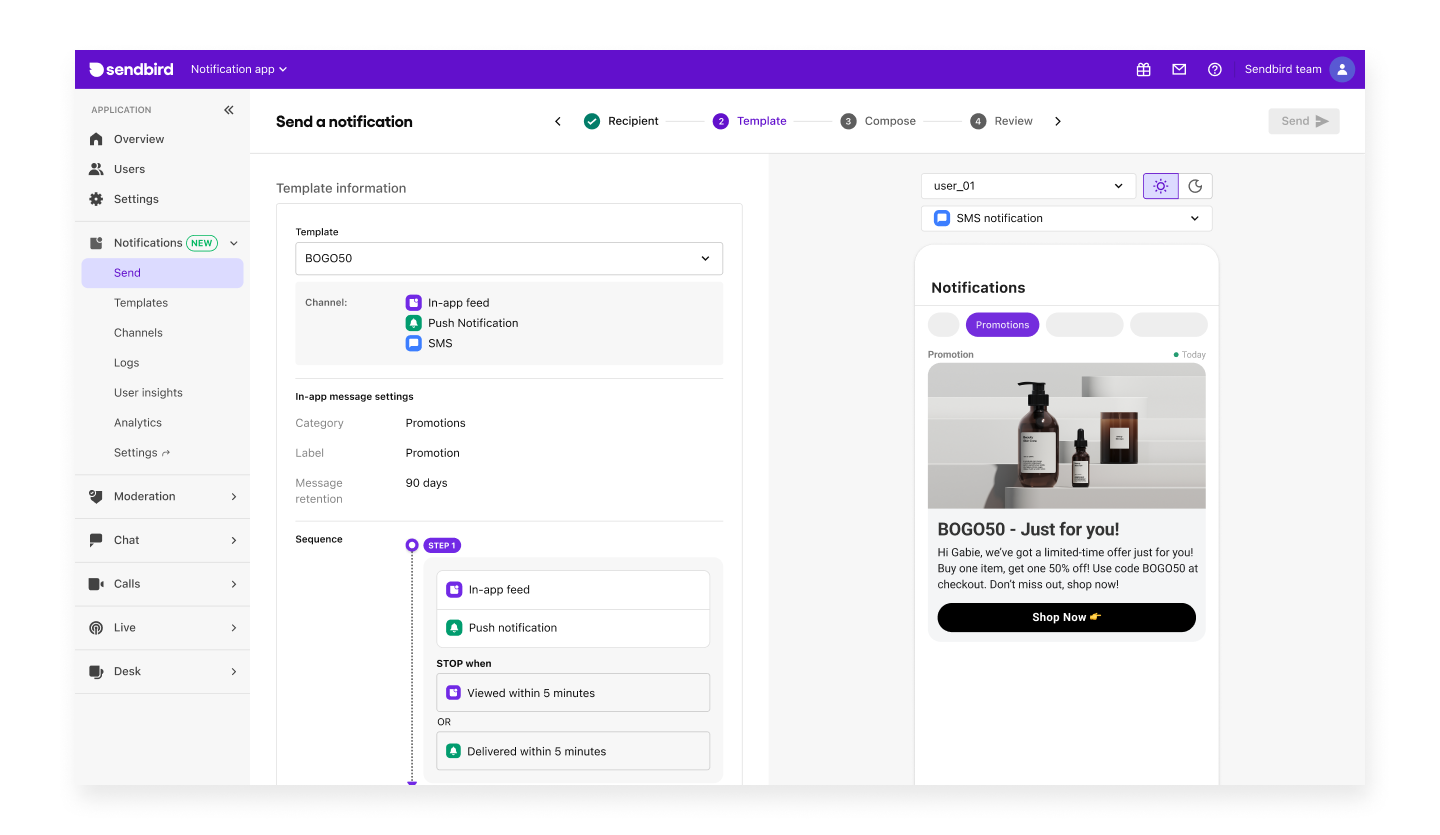
As your subscriber list grows, you can segment your audience based on demographics, purchase behavior, or engagement history. This way, you can send more personalized and relevant messages to different audiences, using channel sequencing to automate SMS delivery by audience.
Track your results
You can analyze campaign performance using the built-in analytics and reporting tools in text message marketing software, or with tracking links from URL shorteners like Bitly.
Here are key SMS marketing KPIs:
Delivery rate: The percentage of messages that successfully reach recipients. A low rate indicates you may need to prune old numbers from your list.
Open rate: A measure of immediate engagement, this can reflect whether your customer messaging frequency should be adjusted up or down.
Click-through rate (CTR): The percentage of recipients that click the CTA link in your message, reflecting the quality of SMS copy and CTA.
Unsubscribe rate: The rate at which people opt out after receiving your text marketing can indicate how relevant or valuable your messaging is.
The 5 top SMS marketing software
If you’re ready to take advantage of SMS as a marketing channel, you’ll probably want an SMS automation tool that can handle the heavy lifting for you.
There are lots of business text messaging apps and software to choose from, including these top SMS marketing platforms:
1. Sendbird
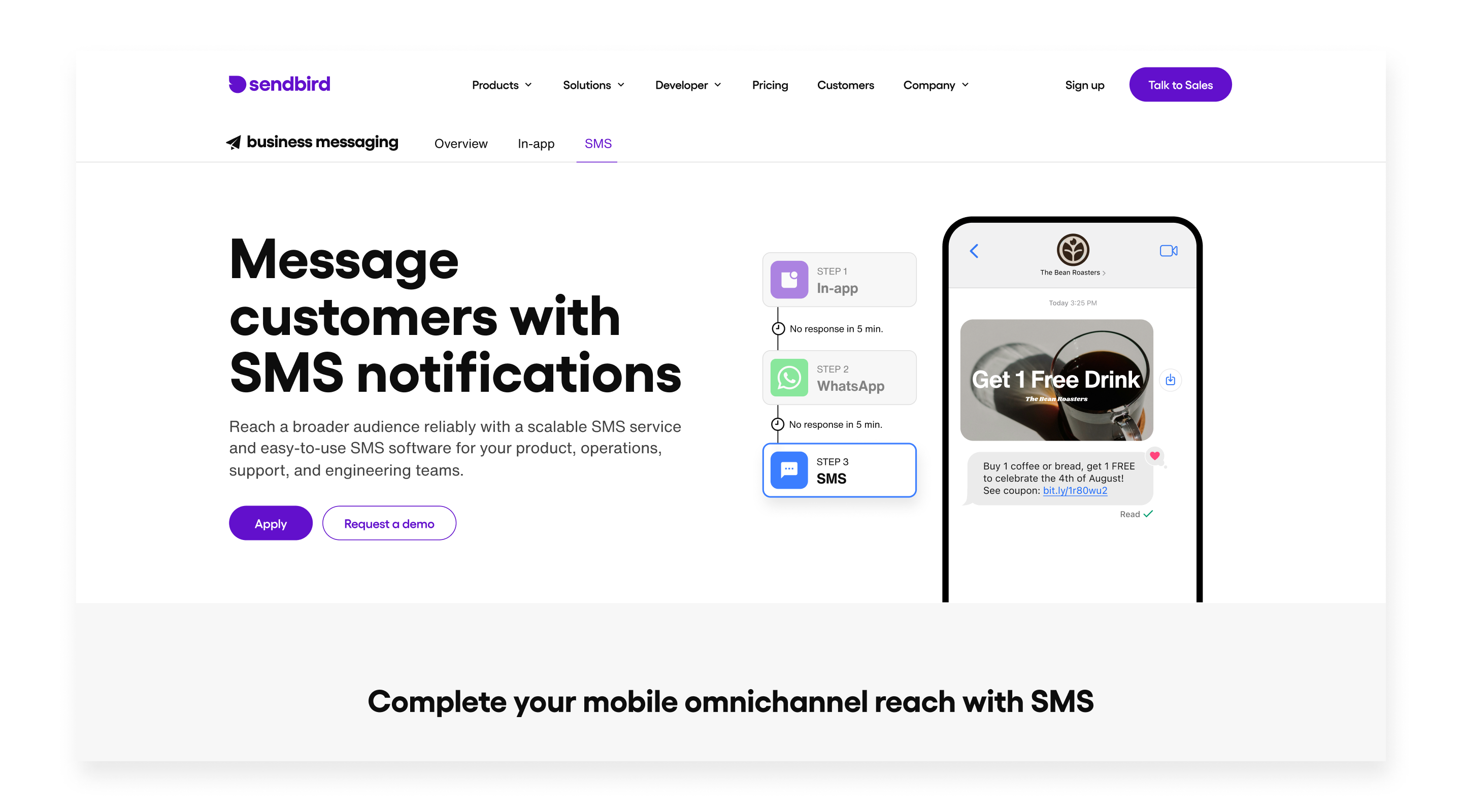
Sendbird is a business messaging platform that gives you all the tools to build a scalable, customized SMS experience using a developer-friendly SMS API. You can easily integrate SMS functionality with your existing systems, workflows, and customer data, then create, automate, and analyze SMS campaigns in one dashboard.
Sendbird allows for extensive customization (unlike out-of-the-box solutions) so you can tailor your SMS strategy to your specific needs, whether you need simple text messages or complex, multi-step omnichannel interactions.
Designed for omnichannel strategies, Sendbird integrates with a wide range of third-party tools like Shopify and Salesforce, plus offers integrations for channels like push notifications, in-app messages, and WhatsApp.
Pros: Flexibility, scalability, omnichannel ready
Cons: Basic coding skills required for launch; no code afterwards
Pricing: SMS pricing is usage-based so you only pay for what you need. Please contact Sendbird for a custom pricing quote or an SMS demo.
2. Attentive
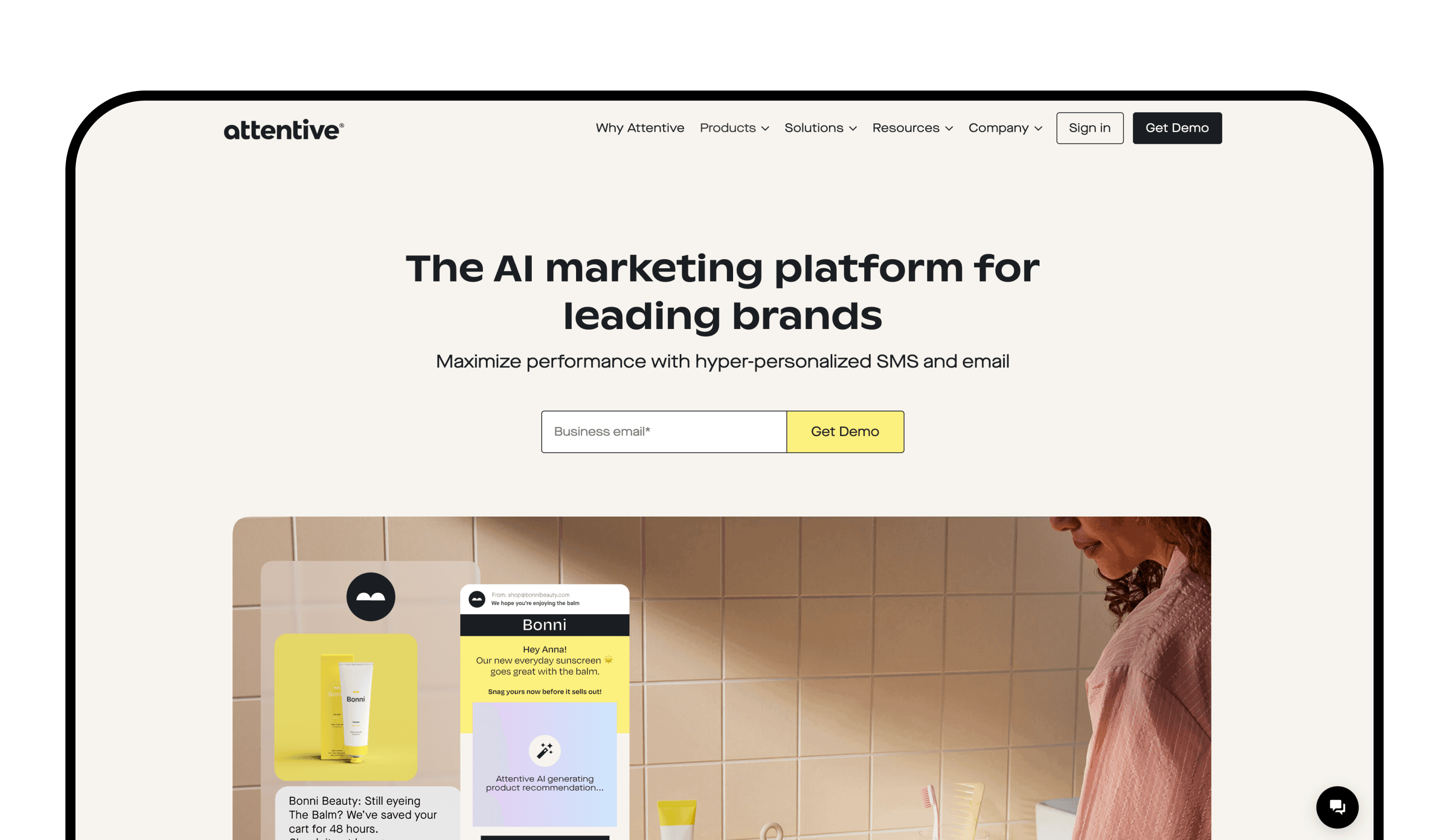
Attentive is an SMS marketing platform that helps you create and personalize SMS and email campaigns. Known for its easy-to-use interface, SMS builder, and high-quality support, Attentive offers a straightforward approach to text message marketing that makes it popular with small businesses. You can integrate SMS campaigns with your email subscriber list and deliver targeted messages to various audience segments.
Attentive gives you all the standard SMS marketing features, such as: text scheduler, two-way texting, automatic replies, MMS marketing, automatic URL shortening, and more. It also offers an SMS service team that can write message copy and design forms and pop-ups for an upcharge — which really rounds out this excellent platform for SMS marketing.
Pros: User friendly, customer support
Cons: Personalization only on simple actions, pricing inconsistency
Pricing: $300/month, plus $0.01 per SMS and carrier fees
3. SlickText
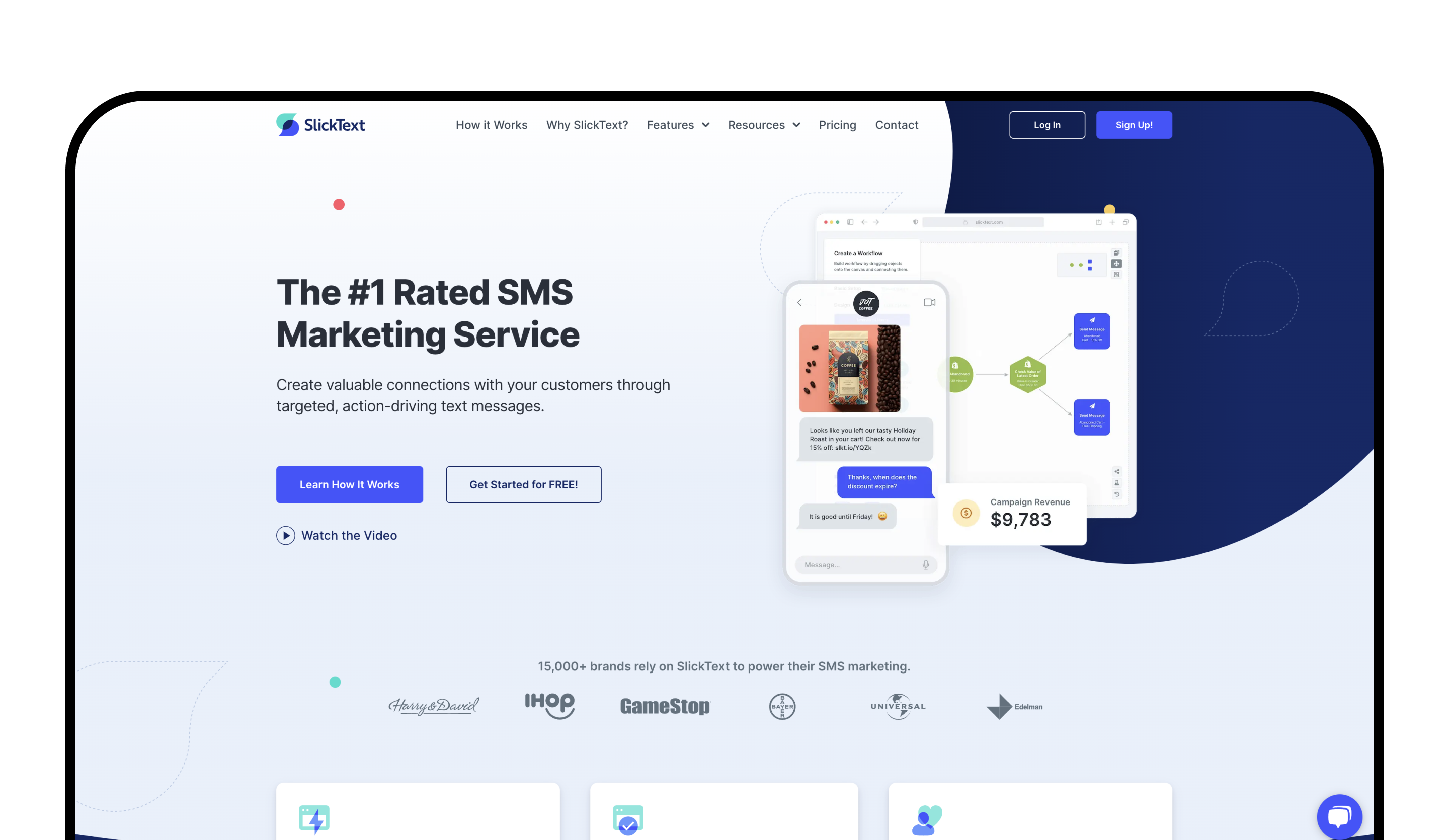
SlickText is a SMS marketing platform known for its comprehensive suite of tools for business messaging and text message marketing.
Popular among retailers and restaurants, SlickText offers robust automation workflows as well as standard SMS messaging features, such as: mass texting, two-way messaging, SMS automation, SMS integration with marketing tools, and text-to-join keyword campaigns.
Overall, SlickText is a great platform for personalized SMS marketing automation and business-to-consumer engagement.
Pros: User friendly, automation workflows, growth tools
Cons: SMS only. There’s no support for email or push notifications that may be part of omnichannel strategies.
Pricing:$29.99 for 500 texts/month, $49/99 for 1,000 texts/month
4. Klaviyo
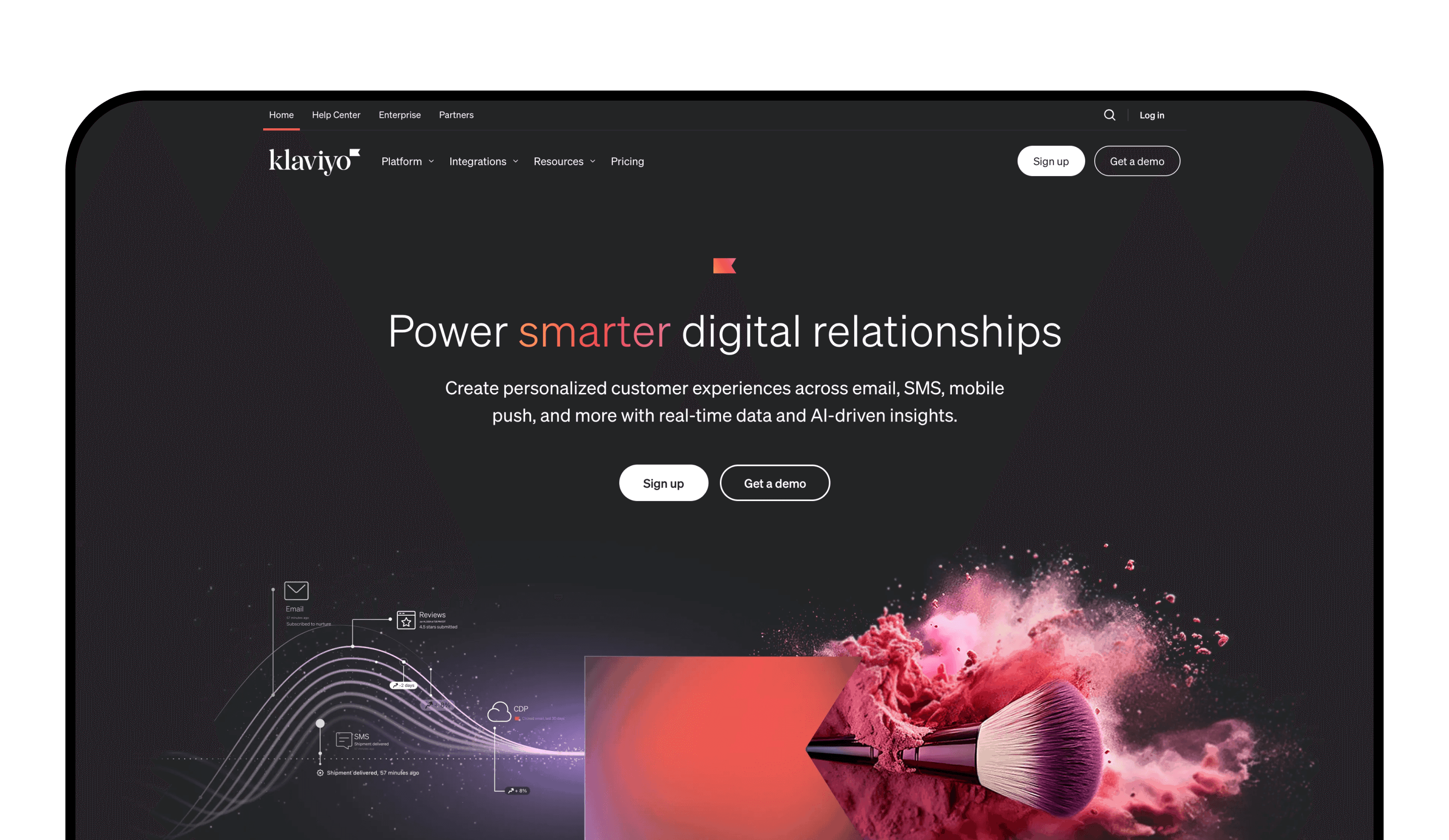
Klaviyo is a popular marketing automation platform for sending personalized SMS and email campaigns. It offers instant integrations, numerous phone number types, and a robust set of features like pre-built templates, dynamic segmentation, bulk SMS messaging, and A/B testing to help you send the right message to the right person. Great at personalization and SMS automation, Klaviyo also offers drag-and-drop templates for signup forms and pop ups.
Pros: Robust features, easy integrations
Cons: Expensive, learning curve
Pricing: $60/month for 1,250 SMS credits with email. Free plan includes 150 SMS credits.
5. Omnisend
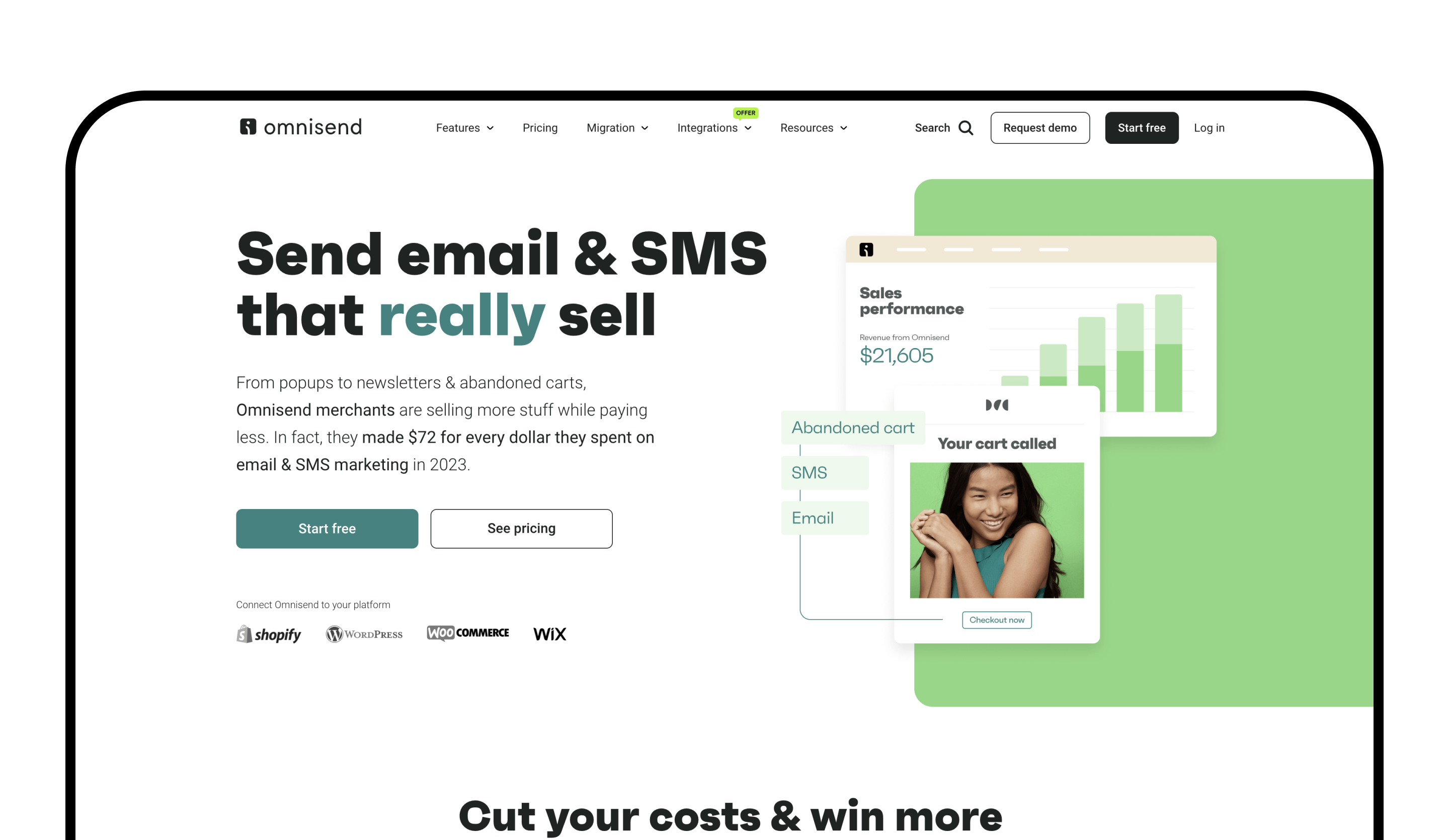
Omnisend is a marketing automation platform for ecommerce businesses that focuses on email, SMS marketing, and push notifications. You can create cross-channel campaigns, automate sending, and track performance with robust automation workflows, all backed up by quality customer support.
While not the cheapest option, Omnisend does a great job of allowing you to streamline marketing efforts and reach customers across different channels.
Pros: Automation workflows, customer support
Cons: Limited number of SMS contacts may not be suitable for large businesses
Pricing: Starts at $15 for 1000 SMS messages.
Is SMS marketing legal?
Yes, SMS marketing is legal. However, there are a few regulatory requirements that businesses must comply with.
In the United States, SMS marketing is governed by the laws of the Telephone Consumer Protection Act (TCPA) and the CAN-SPAM Act. In particular, the TCPA defines the rules for obtaining content from consumers before sending promotional SMS messages.
To ensure SMS marketing compliance, a business must:
Obtain explicit consent (opt-in) from recipients
Provide clear and easy opt-out options
Respect do-not-call lists and timing restrictions
Avoid misleading or deceptive content
Identify your business clearly in the message body
It’s critical to observe these regulations to avoid potential legal issues and reputational damage to your business. Using an SMS marketing platform with SMS compliance management features can help.
How to start SMS marketing
SMS marketing offers direct and cost-effective communication with customers, making it a powerful tool for businesses.
Millions of ecommerce, healthcare, finance, and service businesses use SMS marketing for its immediate delivery, high open rates, and demonstrated ability to drive conversions.
To start with SMS marketing, build your subscriber list.
Then use SMS marketing software like Sendbird to streamline campaigns, orchestrate channels, create personalized messages, and measure performance.
Consider using MMS for a richer messaging experience, and be sure to sync SMS with your larger marketing strategy for best results.
Ready to send your first SMS marketing message? It's easily done with Sendbird Business Messaging and our trusted SMS API service.









